What Kind Of Colors Did Matisse Use During His Fauve Period To Communicate Emotions And Sensations?
The Dance by Matisse was produced in 1910 for Sergei Shchuken, a man of affairs from Russia. Matisse's The Dance features a dancing circle of figures and is regarded as a highlight of the artist's career in the farther advocacy of contemporary art. It is not the outset Dancers painting and was preceded by a preliminary version which has been titled Trip the light fantastic (I) (1909). It was followed by the triptych landscape titled The Dance II in 1932.
Table of Contents
- 1 The Dance by Matisse
- 1.one A Brief Introduction to Henri Matisse
- ii Matisse's The Trip the light fantastic Paintings
- 2.1 The Dance (1910)
- 2.ii The Dance Ii (1932)
- 3 Frequently Asked Questions
- 3.ane What Is an Example of Matisse's Line Drawing?
- 3.2 Tin can Y'all Give a Brief Matisse Dance Analysis?
The Trip the light fantastic past Matisse
Henri Matisse was fascinated by the notion of dancing and the potential to be moved by music. This curiosity became a recurring theme in Matisse's artworks. Despite this, his Dancers painting did non earn the acclaim it has today when information technology was originally presented. In this article, we will try to comprehend a picture full of smart references and then that we may improve capeesh the actual spirit of the Matisse Dancers.
Merely who was the artist behind the famous dancing circumvolve painting? Allow united states first commence with a short introduction to Matisse himself.
A Brief Introduction to Henri Matisse
| Nationality | French |
| Date of Birth | 31 December 1869 |
| Date of Expiry | 3 November 1954 |
| Place of Nativity | Overnice, France |
Henri Matisse is typically best-selling as the most outstanding colorist of the 20th century, rivaling Pablo Picasso in regards to the significance of his innovation. He was a post-Impressionist who grew to recognition every bit the head of the French movement Fauvism. Despite his fascination with Cubism, he eschewed it in favor of using color equally the cornerstone for expressive, ornamental, and very oftentimes monumental canvases.
He once said, dubiously, that he wanted to produce work that would take "a soothing, relaxing effect on the psyche, somewhat like a nice couch."
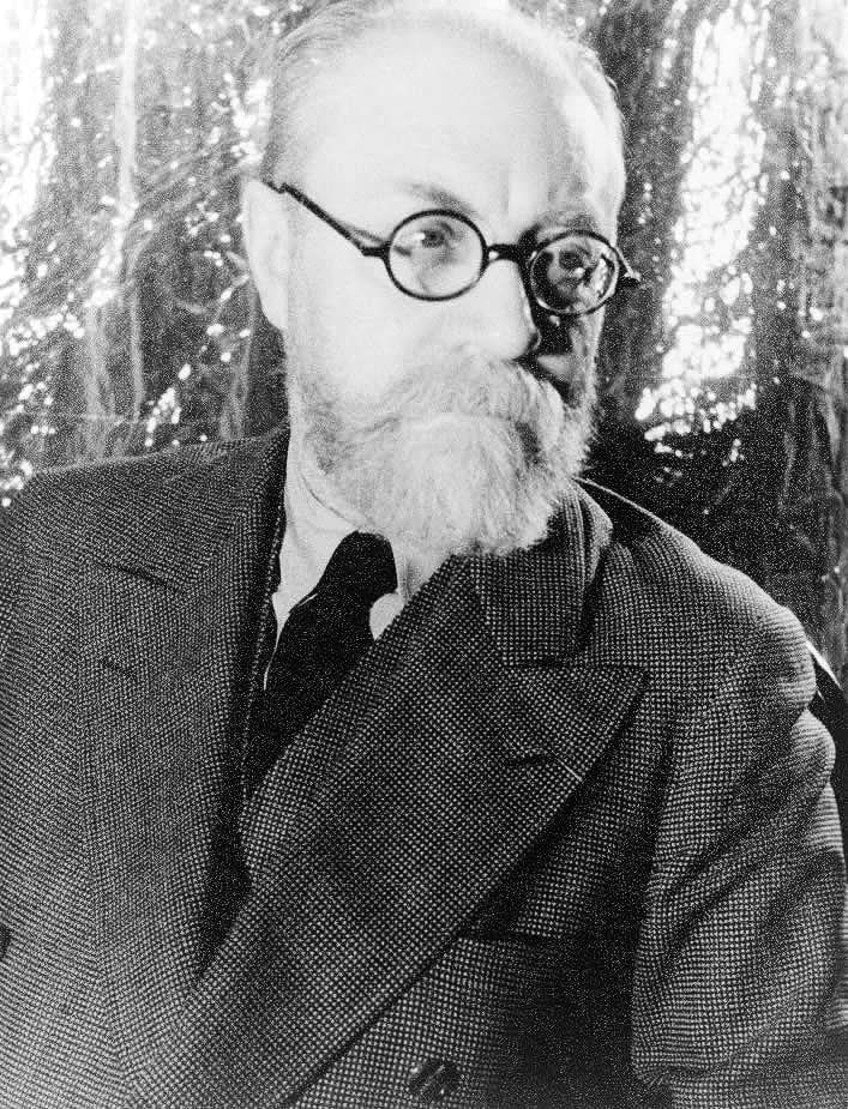 Portrait of Henri Matisse, 1933;Carl Van Vechten, Public domain, via Wikimedia Commons
Portrait of Henri Matisse, 1933;Carl Van Vechten, Public domain, via Wikimedia Commons
Still lifes and the naked homo form were beloved subjects all throughout the bridge of his lifetime; North Africa would also evidence to exist a key influence; and, at the end of his life, he made a significant addition to collage art with a set of pieces utilizing color cut-out forms. He was as well a well-known sculptor.
In Matisse'due south Fauve artworks, he practical only pure hues and the white of uncovered canvases to generate an surroundings that was filled with low-cal. Matisse employed opposing sections of pure, unmodulated color to add dimension and course to his paintings rather than utilizing shading or modeling. These concepts remained pregnant to him throughout his tenure.
Matisse's artwork was highly influential in spreading the importance of ornamentation in contemporary art.
Despite often being considered an creative person committed to bliss and a sense of satisfaction, his application of patterns and colors is quite oftentimes disorienting and frightening. Matisse's line drawings and paintings were highly inspired by various civilizations' fine art.
Matisse reportedly stated that he intended his piece of work to be 1 of "harmony, purity, and tranquility complimentary of disturbing or gloomy subject thing," and this ambition influenced those, such as Cloudless Greenberg, who turned to art to requite refuge from the confusion of contemporary life. Matisse's artwork was centered on the human being body. He shattered the figure violently at times, while at others he treated information technology nigh as a curved, ornamental feature. Some of his art reflected his subjects' moods and personalities, but mostly, he utilized them as vessels for his ain sentiments, reducing them to ciphers in his massive works.
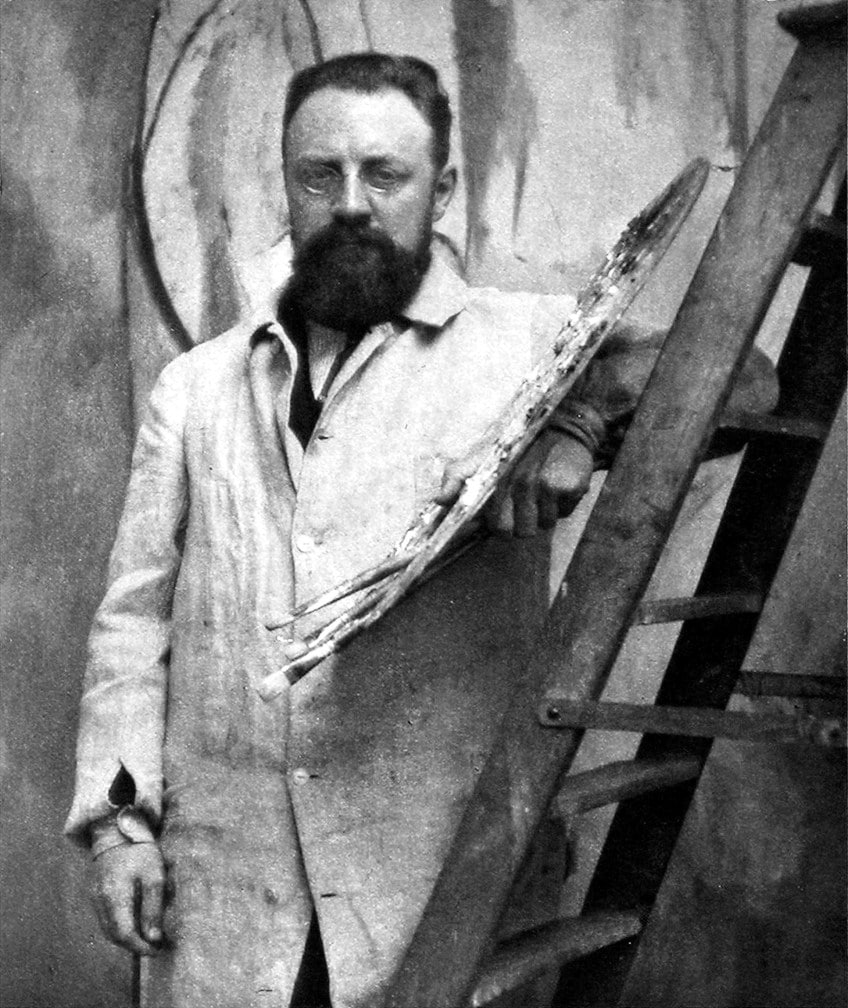 Henri Matisse, Paris, 1913;Alvin Langdon Coburn, Public domain, via Wikimedia Eatables
Henri Matisse, Paris, 1913;Alvin Langdon Coburn, Public domain, via Wikimedia Eatables
Later on witnessing many displays of Asian fine art and going to North Africa, he blended some of the decorative aspects of Islamic art, the angular forms of African sculptures, and the flattening of Japanese prints into his own arroyo.
In the 1950s, scholars saw Matisse and Fauvism as forerunners of Abstract Expressionism and most of gimmicky art.
Some Abstract Expressionists, such as artist Lee Krasner, are influenced by Matisse's many mediums; his paper cut-outs inspired her to slice apart and recreate her own works. Color field artists similar Kenneth Noland and Mark Rothko were drawn to his large fields of intense color, as shown in the Cherry-red Studio (1911).
In contrast, Richard Diebenkorn was more concerned with how Matisse generated the perception of depth and the spatial friction betwixt his subject area affair and the flat sheet. Many, like Robert Motherwell, did not immediately demonstrate Matisse's affect in their works but were impacted by his perspective on color and form in painting.
Matisse'south The Dance Paintings
Matisse's artworks frequently incorporated themes such every bit music and dance. Iii of these paintings share the title The Dance, although the outset one was a preliminary version and The Dance Ii was a mural. We will be touching on the commencement Dancers paintings, only focusing on the last two.
The Trip the light fantastic (1910)
| Title | The Dance |
| Appointment Created | 1910 |
| Medium | Oil on Canvass |
| Dimensions | 260 cm x 391 cm |
| Current Location | The Hermitage, St. Petersburg |
Matisse created an early version of this slice, known as Dance (I), in March 1909. It's a compositional practise with lighter colors and fewer details. The work was highly esteemed by the painter, who once described it every bit "the overwhelming peak of brilliance". Trip the light fantastic is a big ornamental panel produced in conjunction with a counterpart slice, Music (1910), for the Soviet industrialist and art connoisseur Sergei Shchukin, with whom Matisse had a long associate.
This picture, together with "Music", hung on the stairway of Shchukin's Moscow residence until the Oct Revolution in 1917.
The prototype depicts five dancing individuals in bright ruddy confronting a simple greenish background and a beautiful blue heaven. It recalls Matisse's early interest in artwork and employs a traditional Fauvist color palette: the potent warm colors against the green-blue backdrop, every bit well as the syncopated sequence of dancing figures, communicate ideas of emotional liberty and decadence. The flick is oft connected with Igor Stravinsky's famous 1913 musical composition Trip the light fantastic toe of the Young Girls.
 The Trip the light fantastic (1910) by Henri Matisse;Michel B., CC By-SA four.0, via Wikimedia Commons
The Trip the light fantastic (1910) by Henri Matisse;Michel B., CC By-SA four.0, via Wikimedia Commons
When Shchukin ordered Matisse to create this movie, he specifically requested that the dancers exist costumed. Matisse's decision to represent them naked was sensational when he displayed it at the Autumn Salon in Paris. Some even accused him of suffering from a mental ailment. Their creative person/patron connection was strained every bit a outcome of this predicament.
Somewhen, the two agreed that the dancers might exist represented naked, but no genitals would exist overtly portrayed.
The Dance is really a zoomed-in rendition of a department of Matisse's 1905 artwork The Joy of Life. It is historically significant, particularly in terms of the emergence of the Fauvist motion. Matisse was inspired to create this painting after witnessing field laborers dancing on a seashore in the south of France.
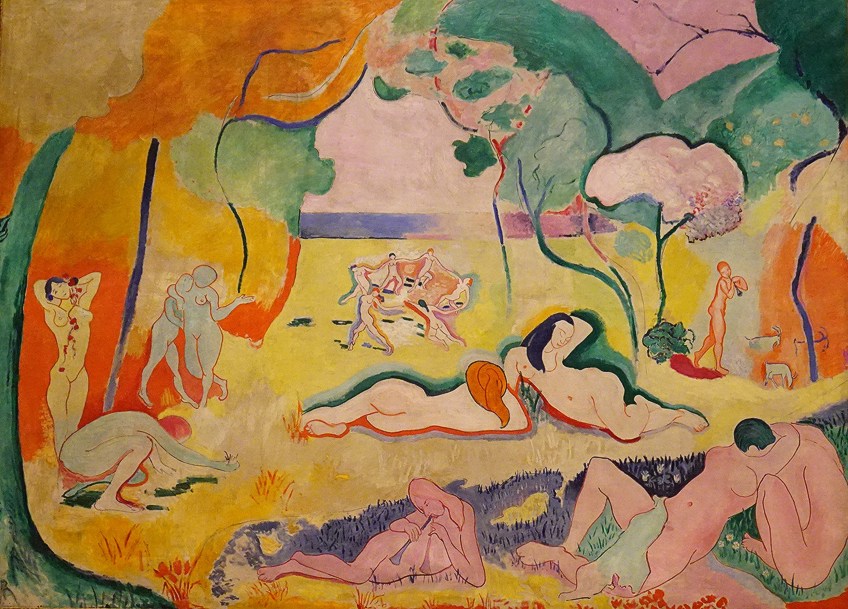 Le Bonheur de vivre (The Joy of Life) (1905-1906) by Henri Matisse;Regan Vercruysse from Phelps, New York, USA, CC BY 2.0, via Wikimedia Commons
Le Bonheur de vivre (The Joy of Life) (1905-1906) by Henri Matisse;Regan Vercruysse from Phelps, New York, USA, CC BY 2.0, via Wikimedia Commons
The figures seem to revolve in a circular motion in both artworks. Matisse, on the other hand, includes just five figures in his circumvolve in The Dance, rather than vi. Their physical parts are reduced, making them appear not-binary, with neither female person nor male features. Their pare tone is likewise uniformly tanned.
The moving-picture show is vast, yet even at these dimensions, the framing is too small for the figures' stature.
Matisse had to make an curvation on some of their backs in society for them to fit completely within the frame. As a issue, their circular aspects draw the audience's eye: the characters on peak are curled every bit if arching their backs, while those on the bottom are extended. Their curves boss the picture, and their circular class, created past interlocking hands, gives the painting a sense of movement and momentum.
The Dance 2 (1932)
| Title | The Trip the light fantastic Ii |
| Appointment Created | 1932 |
| Medium | Landscape |
| Dimensions | 4 m x xiii m |
| Electric current Location | Barnes Foundation |
Matisse as well created a similar Dancer painting, the mural The Dance 2. The landscape was to exist installed over three arches that span the windows of Barnes' gallery'south primary hall. Matisse completed the mural at Dainty, France, using canvas given past Barnes, rather than on-site. This was an uncommon technique for such a piece, but the benefactor had given him an unlimited artistic license, and working onsite would have been impracticable in whatsoever example.
The endeavour was challenging for Matisse, and it concluded up taking him ii years, leaving him physically and emotionally exhausted. He was besides deeply upset to acquire, during the installation, that Barnes had no plans to testify the piece to the public. Still, Matisse was ecstatic virtually the piece. Matisse wrote:
"It has a magnificence that one can merely imagine until one sees information technology, for the unabridged roof and its arched vaults leap to life via radiations, and the chief impact runs all the way down to the floor… I'm quite weary withal charmed. When I watched the painting being hung, information technology divorced from me condign a function of the structure."
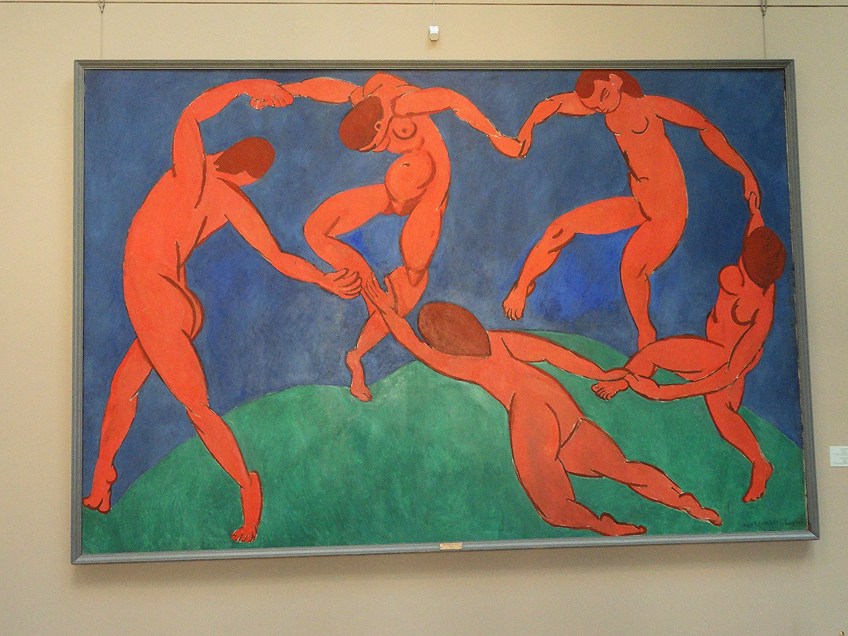 The Dance 2 (1932) past Henri Matisse;Damien, CC By-SA 2.0, via Wikimedia Commons
The Dance 2 (1932) past Henri Matisse;Damien, CC By-SA 2.0, via Wikimedia Commons
Some critics believe that The Dance II mural was pregnant in allowing Matisse to reconnect to the about fundamental foundations of his painting. For Matisse, the slice emphasized features such equally simplicity, flattening, color focus, and the use of paper cut-outs, all of which would eventually play an essential part in his artistic evolution. Barnes granted Matisse complete creative freedom in terms of field of study matter; the understanding only defined the size of the mural and its location on the southeast wall of the Main Gallery.
Matisse appears to have chosen the dancing topic early.
The Barnes Foundation provided him with the chance to retake his identify as a prominent figure in the decorative mural fine art heritage, and to do and so publicly and on a huge scale. The Foundation'due south Main Gallery featured some of the most significant paintings of the second half of the 19th century in 1930; they, too, would nowadays the artist with both a task and a possibility. Matisse's difficulty was to locate himself inside the French heritage of decorating while proclaiming his work as avant-garde.
 A wall with a nameplate affixed to it at the Barnes Foundation in Philadelphia;Thekohser, CC Past-SA 4.0, via Wikimedia Commons
A wall with a nameplate affixed to it at the Barnes Foundation in Philadelphia;Thekohser, CC Past-SA 4.0, via Wikimedia Commons
The utilize of dance as a motif, namely the representation of eternal nudes moving in a circumvolve, not simply recognized classical heritage but also allowed him to illustrate the continuation of his own works. Decorations were large-scale paintings created to fit into a specific context, such as a private room or a place in a public institution. Matisse'due south artistic output was driven past a decorative method of painting and thinking.
Matisse sought for a film whose shape is tensile and extending rather than closed and united, and whose surface consists of broad zones of flat colors that defy the conventional sense of depth and its appeal to patient contemplation.
Instead, the colors extend across the canvass's four edges, immersing the viewer in a dynamic sensory feel. It was obvious from the start that creating an acceptable blueprint for the area where The Dance would hang would be tough. The landscape was supposed to embrace a large area on the southern wall of the Main Gallery, over iii French doors and beneath the curved arches of the roof. The area is divided into 3 semi-continuous lunettes by ii pendentives that driblet down.
Matisse proceeded to Dainty to start work on the mural after finalizing the organization, arriving in mid-January 1931. He began by renting a vacant garage in which he could work to calibration. Matisse started to paint the canvases at some point during this procedure. He liked to work straight on the canvass, with minimal previous detail inquiry, only he ran into a problem: the mural was too vast to accommodate alterations. To remove paint with a turpentine-soaked rag, or to cover up an earlier phase, was a considerably larger undertaking than with a lilliputian easel painting.
He was also near sixty years old, and the task of creating the pattern repeatedly had drawn him.
As a result, he devised a design method based on paper cutouts: rather than painting directly on the canvas, he cut out colorful paper and fastened information technology to the surface of the unfinished, partially painted landscape. All of Matisse's previous sketches and color explorations were at present laid aside, and he began over. He understood what he intended to achieve this time and worked considerably quicker. He laid down three canvases and sketched in the new group of dancers after double-checking his measurements.
In add-on, he modified the composition. Where he had previously constructed a continuous plane of movement, he now separated the work into three points of interest—possibly in reaction to the recalculated size of the pendentives, which were now twice as broad equally in the previous program. He likewise expanded the number of figures from six to 8, placing two dancers for each of the iii lunettes and introducing a pair of goddesses, one below each of the pendentives, to serve equally a span from one lunette to the next.
This impression of expansion, fracturing, and move was intended to engage the observer in active, active interaction with the side by side room's environment.
Matisse claimed that the black grounds of the panels continued the region betwixt the doors, producing the illusion of a "awe-inspiring foundation for the vault." The dark also contrasted with the regions of brilliant calorie-free that entered the space through the French doors. The grayness figures were meant to correspond the stone of the adjacent architecture, while the blue and pink were meant to remember the sky just above the landscape viewable through the doors. The color chord also included the dark-green of the grass, trees, and plants.
Matisse Dance Analysis
Henri Matisse'southward artistic choices for this painting generated quite a stir in the art salons of 1910; the brazen nakedness and awfully placed colors gave the artwork a primal aspect that some observers perceived as barbarous. Matisse depicted this celebration in only 3 colors: blue, light-green, and red. These 3 vibrant colors provide a dramatic contrast, in keeping with Fauvism's traditional colour connotations. According to an art critic who observed Matisse producing the painting in his workshop, "the colors were pure from the tubes."
Because of the economic system of design and detail, the figures are unclear; neither their facial expressions nor gender is easily identified. Against the blueish and light-green backgrounds, cherry-hued silhouettes are simply contoured with thick curves. Matisse investigated the interaction between colors and lines in order to achieve harmony; colors, for him, were not designed to operate in isolation.
Furthermore, there are no structural or landscape aspects to generate a feeling of scale or perspective. The large canvass features a fairly flat background, with the dancing people equally the main focal point.
The Fauves shared the primitivists' marvel in indigenous tribes, and primitivism motivated them to produce art that reverted to the spirit of creation and communion. The coarsely sketched figures in dance call up primitivist aesthetics, and the subject area affair, individuals communing within an empty, maybe "virgin" terrain, might be understood as an abet for a required reunion with nature. The nakedness of the figure, for example, symbolizes a rejection of gimmicky society.
The artwork is transformed into a symbol of oneness between humanity, heaven, and nature. Matisse's goal was to produce a synthesis of primitivism; the awkward forms inspired by rudimentary and folk art, also as the brilliant, lively colors, reflected instinct and environment. Individuals are completely captivated in their dancing, indifferent to any everyday duties or employment.
Matisse focuses on the movement and rhythm created by the dancers more than than their unique await. The trip the light fantastic is the greatest keepsake of private reunion.
The v characters are walking hand in hand in a band, simply on the left, we can encounter that the 2 persons' hands are divided; they brush confronting each other rather than property. Matisse, on the other hand, deliberately placed the rupture where it covers the other figure's leg so as not to disrupt the harmony of the colors and circumvolve. Considering the point of the rupture is closest to the viewer'south location, it might exist taken as an invitation to engage in the trip the light fantastic.
The circle comes to identify those who "are outside," and so to bring people together. Matisse's dancers are in a like state of affairs to those in The Joy of Life's properties. The theme piqued Matisse'south involvement sufficiently for him to isolate it and devote a whole painting to it. Nevertheless, based upon the research of Charles Caffin, Matisse'south obsession with dancing began at the Moulin de la Galette, where he would watch folks dance. This sort of popular dancing contrasts with more than formal, conventional, or classical dance forms such as ballet. The Dance, in this style, provides a commentary on the development of dance.
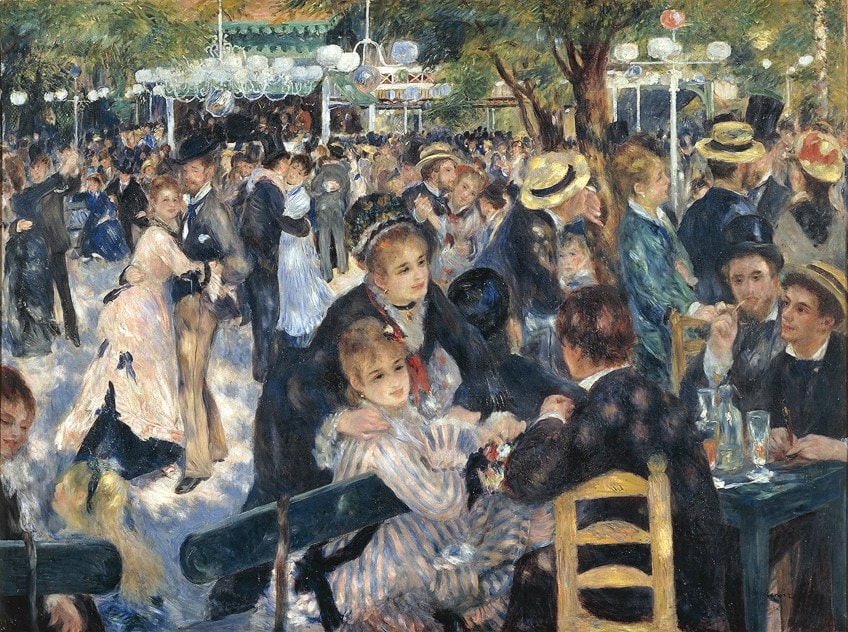 Bal du moulin de la Galette (Ball at the Moulin de la Galette) (1876) by Pierre-Auguste Renoir; Pierre-Auguste Renoir, Public domain, via Wikimedia Commons
Bal du moulin de la Galette (Ball at the Moulin de la Galette) (1876) by Pierre-Auguste Renoir; Pierre-Auguste Renoir, Public domain, via Wikimedia Commons
Despite the painting'southward uncomplicated fashion, Matisse managed to capture a feeling of movement and space in Dance: the dizzying heaven and rounded curves that comprise the basis appear to be imbued with function of the energy radiating from the rhythmically charged bodies. The characters announced to be in a trance, and the observer can practically hear the pounding of the drums and picture a furious dance as they whirl in a circumvolve. Because music provides rhythm, the joint of dance with the music is crucial.
In this sense, it is intriguing to compare Dance to its equivalent Music. Trip the light fantastic's continuous movement contrasts sharply with Music, where the subjects are motionless. The vocalists almost announced to be spectators, staring up at the dancers while laying their arms on their knees.
That concludes our await at "The Trip the light fantastic toe" by Matisse. Matisse's "The Dance "depicts a dancing circle of individuals and is recognized as a high signal in the artist's career as well as the growth of modernistic art. It is non the first "Dancers" painting, although it was preceded by a preliminary version titled "Trip the light fantastic toe" (I) (1909). In 1932, it was followed past "The Dance Two", a triptych mural.
Oftentimes Asked Questions
What Is an Instance of Matisse's Line Drawing?
There was a lot of overlap between Henri Matisse's paintings, sketches, and cut-out artworks. When looking at this artist's techniques of creation, you might debate that information technology makes more sense to look at it every bit a whole rather than breaking it down into dissimilar mediums. An case of Matisse's line drawings is Vase de Fleurs (1944).
Can You Give a Brief Matisse Dance Analysis?
Matisse'southward Dancers painting used but iii hues to express this celebration: blueish, light-green, and red. In line with Fauvism'south typical color implications, these 3 bright hues make a dramatic contrast. "The colors were fresh from the tubes," said an art critic who saw Matisse working on the painting in his workshop. The figures are obscure due to the economic system of design and detail; neither their facial expressions nor gender is conspicuously determined.
Source: https://artincontext.org/the-dance-matisse/
Posted by: rosasfroopped.blogspot.com


0 Response to "What Kind Of Colors Did Matisse Use During His Fauve Period To Communicate Emotions And Sensations?"
Post a Comment